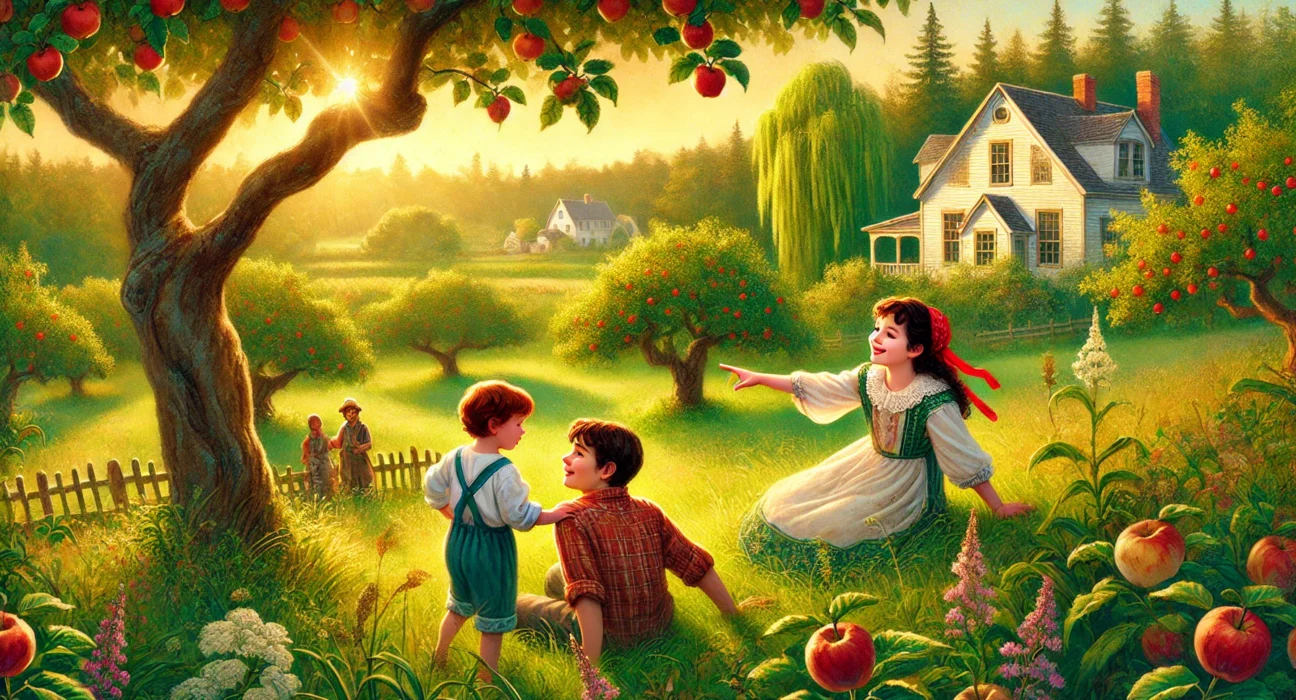“The Story Girl,” written by Lucy Maud Montgomery and published in 1911, invites readers into a nostalgic world set in the pastoral landscape of Prince Edward Island. Known for her enchanting storytelling, Montgomery weaves a narrative through the eyes of two young brothers, Beverley and Felix King, who leave Toronto to spend a summer with their relatives in the charming rural community of Carlisle. The story revolves around their experiences and adventures, significantly influenced by their cousin Sara Stanley, fondly known as the Story Girl for her captivating storytelling abilities.
Comprehensive Plot Summary
On a bright May morning, Beverley and Felix King left Toronto, hearts filled with anticipation, bound for the old King homestead on Prince Edward Island. Their father, tasked with managing a new branch in Rio de Janeiro, sent them to live with Uncle Alec and Aunt Janet in the rural community of Carlisle. The boys, brimming with excitement and curiosity, envisioned the landscapes their father had lovingly described, filled with the echoes of his own boyhood.
As they arrived, the familiar scenery began to unfold. The sprawling farm, the old willow tree planted by their grandfather, and the famed King orchard came into view. The boys were welcomed by a bustling household and an array of cousins: the beautiful but vain Felicity, the sweet and demure Cecily, and the mischievous Dan. However, it was their cousin Sara Stanley, known as the Story Girl, who captivated their imaginations. Her strikingly vivid storytelling made her the central figure in their summer adventures.
The Story Girl’s enchanting tales breathed life into their everyday surroundings. From the eerie legends of family ghosts to whimsical stories about the orchard, Sara’s narratives transformed the mundane into the magical. The children explored the King’s farm, the apple orchard, and other local landmarks, each imbued with the enchantment of her stories. One memorable tale was about Emily King, a tragic figure whose ghost was said to haunt the orchard, a symbol of unfulfilled love and lingering family legacy.
As summer progressed, the children faced various challenges and embarked on numerous adventures. They navigated misunderstandings, playful conflicts, and shared joys, all while the Story Girl continued to enchant them with her vivid tales. The introduction of Peter Craig, a hired boy with a humble background, added a new dynamic to the group. Initially met with disdain by Felicity, Peter’s journey into churchgoing, encouraged by the Story Girl, became a subplot highlighting themes of acceptance and personal growth.
The children’s days were filled with imaginative games and heartfelt discussions, grappling with concepts of life, death, and love. A particularly haunting tale was the story of the Wedding Veil of the Proud Princess, a cautionary tale about the dangers of pride and the fleeting nature of beauty. In this story, a proud princess demanded to marry the king who could conquer all kings. When Death himself came disguised as a king and took her to his kingdom of tombs, it served as a stark reminder of mortality and humility.
Their adventures extended beyond storytelling. They celebrated birthdays with grand festivities, held impromptu performances, and engaged in various escapades that strengthened their bonds. One significant event was the boys’ effort to catch glimpses of the Story Girl’s ghost, leading to nighttime ventures into the orchard. Despite their fear, the presence of the Story Girl made each expedition thrilling and memorable.
Amid these escapades, the children developed deep friendships and learned valuable life lessons. The King orchard, a place steeped in family history, became a central symbol of their adventures. Planted by their great-grandfather, each tree held a story, whether it was the “birth trees” marking family celebrations or the mysterious seedling that no one could eat from. The orchard was a living testament to their heritage, intertwining their present with the past.
The Story Girl’s tales often mirrored the children’s own experiences, blurring the lines between fiction and reality. Her story of the Poet Who Was Kissed recounted how their Great-Aunt Edith had unknowingly kissed a famous poet, mistaking him for a relative. This romantic and whimsical tale, like many others, added a layer of enchantment to their daily lives.
Peter’s integration into the group was not without challenges. His rough background and initial hesitation to attend church were met with varying reactions from the cousins. The Story Girl’s persistent encouragement led to his eventual attendance, marking a significant step in his personal growth. His journey highlighted the themes of social acceptance and the transformative power of kindness and patience.
Throughout the summer, the children’s explorations and the Story Girl’s tales created a tapestry of unforgettable memories. They found themselves in situations that tested their courage, loyalty, and understanding of the world. Whether it was a midnight venture into the orchard or a heartfelt conversation about the future, each moment was infused with the magic of the Story Girl’s narratives.
As the summer days waned, the bonds forged through their shared experiences grew stronger. The King homestead, with its rich history and beautiful landscapes, became a cherished place of belonging. The children realized that their adventures, guided by the Story Girl’s tales, had not only filled their summer with joy but had also shaped their understanding of family, friendship, and the power of storytelling.
In the end, the boys knew they would carry the memories of this magical summer and the lessons learned from the Story Girl’s tales into their future. The old homestead, the orchard, and the enchanting stories had woven a spell that would stay with them forever, a testament to the enduring magic of childhood and the timeless power of a good story.
Main Characters
- Beverley King: The narrator of the story, Beverley is reflective and sensitive. His observations provide insight into the dynamics of the group and the enchanting influence of the Story Girl.
- Felix King: Beverley’s younger brother, Felix is chubby and self-conscious about his weight. He is earnest and often provides a humorous counterpoint to the adventures.
- Sara Stanley (The Story Girl): A charismatic and gifted storyteller, Sara captivates everyone with her tales. Her ability to bring stories to life makes her the central figure in the children’s adventures.
- Felicity King: The acknowledged beauty of the group, Felicity is conscious of her looks and somewhat vain. Despite this, she is capable and often takes on a leadership role in their activities.
- Cecily King: Gentle and kind, Cecily is overshadowed by Felicity’s beauty but is cherished for her sweet nature and practicality.
- Dan King: Mischievous and adventurous, Dan is always ready for a new escapade. His playful nature often leads the group into exciting, if sometimes troublesome, situations.
- Peter Craig: A hired boy with a rough background, Peter becomes an integral part of the group. His journey reflects themes of social acceptance and personal growth.
Themes and Motifs
- Storytelling and Imagination: Central to the narrative is the power of storytelling, embodied by the Story Girl. Her tales blend reality and fantasy, enriching the children’s experiences and teaching them valuable lessons.
- Family and Belonging: The story explores the deep bonds of family and the sense of belonging. The King family homestead is a place of heritage and shared memories, where the children connect with their roots.
- Growth and Self-Discovery: Throughout the summer, each child undergoes personal growth. They confront their fears, embrace their strengths, and learn important life lessons, often guided by the wisdom in the Story Girl’s tales.
- Tradition and Change: The story contrasts the enduring traditions of the King family with the inevitable changes brought by time and personal growth. The orchard, with its historical significance, symbolizes this balance.
Writing Style and Tone
Lucy Maud Montgomery’s writing style in “The Story Girl” is characterized by its lyrical quality and vivid descriptions. Her language is rich and evocative, capturing the beauty of Prince Edward Island’s landscapes and the innocence of childhood. The narrative is imbued with a sense of nostalgia, reflecting a longing for simpler, more idyllic times.
Montgomery employs a tone that is both whimsical and poignant, seamlessly blending humor with moments of deep emotional resonance. Her characters are brought to life through their dialogues and interactions, making the reader feel a part of their world. The author’s ability to weave moral lessons into engaging stories ensures that “The Story Girl” is not just a tale of childhood adventures but also a reflection on the enduring power of stories to shape our lives and values.
If this summary has sparked your interest, we would appreciate you subscribing to our newsletter.
There’s a treasure trove of other fascinating book summaries waiting for you. Check out our collection of stories that inspire, thrill, and provoke thought, just like this one by clicking here.
If you want to request a book summary, click here.
When Saurabh is not working/watching movies/reading books/traveling, you can reach him via Twitter/X, or LinkedIn.
Restart reading!






